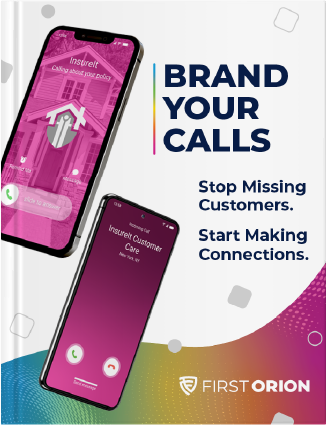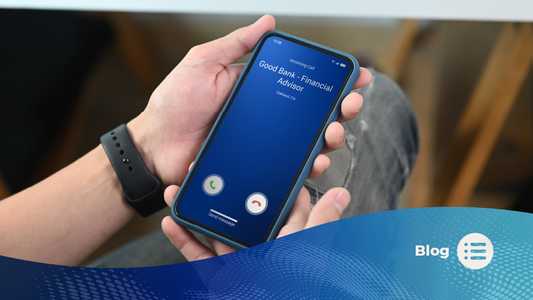Most people don’t answer calls from numbers they don’t recognize, according to Pew Research1. First Orion’s Branded Calling solution changes this by displaying your verified business name, logo, and call reason directly on customer devices.
INFORM® Branded Calling offers up to 32 characters of customizable text, your logo (available with INFORM with Logo), and the specific call reason, such as “appointment reminder,” across all major U.S. mobile carriers. When recipients see and recognize your brand information instead of an unknown number, they answer with confidence. This transparency transforms the calling experience from the moment your number appears on screen.
INFORM Branded Calling reaches customers on connected devices in the U.S. and more than 21 million in Canada. Our solutions work across every major U.S. carrier, including T-Mobile, Verizon, and AT&T.
Benefits of Branded Calling include:
- Building Customer Trust and Loyalty – Customer engagement increases with more transparency in every interaction.
- Protect Brand Reputation – Separate yourself from the spoofers and scammers by showcasing your name when you call.
- Increase Your ROI – More engagement = more conversions.
How to Get Started
- Register Your Numbers – First Orion validates that you are a legitimate business and verifies your calling numbers. Complete registration here.
- Manage Your Programs – Create and manage your calling programs in our easy-to-use Customer Portal. Calls will be branded per program.
- Optimize Your KPIs with Analytics – The analytics provided in the Customer Portal allows businesses to make actionable insights to optimize their calling programs and maximize their ROI.
Control Call Volume and Patterns
Carriers monitor calling patterns to detect spam and robocalls. By managing your call volumes strategically, you avoid triggering these automated filters that could flag your legitimate business calls.
For success, distribute your call volume evenly throughout business hours rather than creating rapid bursts in short periods. Never make calls outside normal business hours, as this pattern resembles spam behavior. When you rotate numbers to handle higher volumes, maintain consistent branding across all numbers in your rotation pool.
Balance Your Inbound and Outbound Traffic
Carriers trust phone numbers that handle both incoming and outgoing calls. They view balanced traffic more favorably than purely outbound activity because a one-to-one ratio of inbound to outbound calls signals legitimate business operations. Numbers that only make outbound calls resemble robocall patterns and attract scrutiny.
Build Inbound Volume with These Strategies:
Display your direct phone numbers prominently in emails and marketing materials. Train your agents to invite customers to call back and ensure the numbers you use for outbound calls can receive inbound calls. Route incoming calls to the same numbers you dial from.
Customer service lines naturally generate inbound activity. Coordinate number usage across your teams to maintain healthy ratios that keep carriers confident in your legitimacy.
Maintain Clean Lists and Stay Compliant
Regulatory compliance and list hygiene protect both your customers and your business reputation. Violations result in significant financial penalties and long-term damage that affects your ability to reach customers.
Essential Compliance Steps:
Scrub your calling lists against the National Do Not Call Registry before each campaign and maintain your internal Do Not Call list. Process opt-out requests immediately and document everything. Follow TCPA time restrictions by never calling before 8 a.m. or after 9 p.m. in the recipient’s local time zone.
Use dialers with time zone awareness to automatically enforce calling windows and automate list scrubbing and logging through your CRM or compliance software.
Your Compliance Checklist:
- Monthly National Do Not Call Registry scrubbing
- Immediate processing of internal opt-out requests
- Time zone aware call scheduling
- Documentation of all compliance activities
- Regular staff training on calling regulations
Automated prevention systems and clear audit trails give you the protection you need against compliance violations that could cost your organization dearly.
Authenticate Your Numbers
Call Authentication provides businesses with a way to prove their calls are legitimate. By working directly with the business, Call Authentication verifies the business as the calling party, the party they are calling, and the precise timeframe the call is made.
When purchasing INFORM with logo or SENTRY® Call Blocking, this authentication process ensures that only legitimate calls receive branded display treatment, while spoofed calls are intercepted and blocked before reaching the customer.
With INFORM with Logo, authenticated calls get through and arrive with business identity clearly displayed, boosting reputation and restoring confidence in phone communication.
Integrate Technology for Personalization and Efficiency
Your CRM and auto-dialing systems become more powerful when you integrate them with branded calling. This combination personalizes calls at scale while improving operational efficiency.
Technology That Drives Results:
CRM and auto-dialer integration provides real-time access to customer information during calls. Speech analytics monitor call quality, ensure compliance, and identify coaching opportunities for your team. AI-powered compliance tools detect risky behaviors and maintain list hygiene automatically. Predictive analytics optimize call timing and messaging strategies based on customer response patterns.
These integrated systems reduce manual work, improve call relevance, and proactively protect your number reputation without adding to your team’s workload.
Troubleshoot Caller ID Mismatches
Caller ID problems reduce trust and answer rates immediately. These issues stem from data problems, network configuration, or device settings and create symptoms like missing business names, outdated information, incorrect spellings, inconsistent displays across carriers, or spam warnings on legitimate calls.
When customers repeatedly see incorrect caller ID, they learn to ignore your calls. This creates complications with regulatory identification requirements and damages your ability to reach people who actually want to hear from you.
Identify the Root Cause
Start by understanding what’s causing the incorrect display:
- Unregistered numbers or outdated business information in carrier databases
- Misconfigured or stale caller ID name (CNAM) records
- Carrier database synchronization errors spreading incorrect information
- Device or app settings overriding carrier-provided caller ID
- Reputation problems triggering spam labels
Test your numbers across different carriers and device types, collect screenshots of incorrect displays, and log specific times and numbers. This documentation proves invaluable when escalating issues to carriers.
Quick Diagnostic Guide:
| Symptom | Likely Cause | Resolution Approach |
| No business name displayed | Unregistered number | Complete carrier registration |
| Wrong business name showing | Outdated CNAM record | Implement Branded Calling |
| Inconsistent display across networks | Carrier database sync issues | Contact multiple carriers |
| Spam or scam warnings appearing | Reputation issues | Implement reputation management |
Update Your CNAM Records
CNAM controls the business name associated with your phone number. Keep it accurate and consistently formatted to ensure customers see the right information.
The Update Process:
Submit CNAM changes through your telecom provider or a third-party CNAM management service. Allow 15 to 30 business days for changes to propagate across carrier networks, so plan for rebranding or name changes. Review your CNAM records quarterly and coordinate updates with your marketing team for consistency.
Carriers typically limit CNAM to 15 to 20 characters, requiring concise naming conventions. Third-party CNAM services format entries properly and coordinate updates across multiple carriers simultaneously, saving you time and ensuring consistency.
Address Network and Device Issues
Even correct CNAM records can display incorrectly due to network routing or device settings.
Common Problems to Watch For:
Smartphone spam filters sometimes incorrectly label legitimate calls. Locally saved contacts or third-party apps can override carrier-provided caller ID. Carrier routing differences cause inconsistent presentation across networks.
Your Testing Strategy:
Test across major carriers like Verizon, AT&T, and T-Mobile. Verify display on both iOS and Android devices and check for spam filter interference. Log inconsistencies by specific carrier and device type, then escalate to technical support with documented evidence.
This systematic approach isolates whether problems originate from carriers, specific device types, or third-party applications.
Work with Carriers and Platforms
Compile comprehensive evidence before contacting carriers. Gather affected phone numbers, examples of incorrect displays, timestamps, and proof of number ownership. Clear, well-documented examples speed up carrier investigations significantly.
Third-party caller ID management platforms coordinate updates across multiple carriers and handle CNAM, branding, and reputation management at scale.
Resolution Timelines to Expect:
- CNAM changes: typically 15 to 30 business days
- Reputation or filtering issues: may require 60 to 90 days with active remediation
Keep detailed records of all communications and escalation steps. This documentation supports regulatory appeals if carriers fail to resolve legitimate issues in reasonable timeframes.
Establish Best Practices for Number Management
Systematic controls keep your caller ID consistent, trustworthy, and compliant across all business communications.
Core Practices That Protect Your Reputation:
Use unified naming conventions across all phone lines and choose clear, recognizable names within carrier character limits. Monitor number reputation and call analytics regularly, provide comprehensive staff training on outbound calling protocols, and conduct routine compliance audits with proper documentation. Build partnerships with carrier representatives for faster issue resolution.
These practices combine to create a scalable caller ID management program that protects your reputation and maximizes calling effectiveness.
Standardize Across All Business Lines
Regional name variations and departmental differences weaken brand recognition. Centralize your approved caller ID formats and audit new numbers regularly to prevent inconsistencies from developing as your organization grows.
Cross-department coordination and clear documentation prevent inconsistent presentations when you add new phone numbers.
Choose Names Customers Recognize Instantly
Avoid generic labels like “CUSTOMER SERVICE” without brand context. Work within carrier character limits using recognizable abbreviations when necessary.
For regulated industries, include required identifiers according to disclosure rules. Test your caller ID formats with customer feedback before full deployment to ensure they build trust immediately.
Monitor Your Reputation and Analytics
Track answer rates, spam or scam label frequency, customer complaints, call completion rates by carrier, and callback rates. Set up automated alerts for reputation declines and document trends that guide your remediation efforts.
Early detection of declining performance enables corrective action before problems affect your entire calling operation.
Train Your Teams Continuously
Your staff’s calling behaviors directly affect your organization’s reputation. Train them on caller ID best practices, compliance requirements, and the impact of their actions through onboarding sessions, quarterly refresher training, role-playing exercises, and call monitoring.
Document all training activities and assess outcomes to support compliance reporting and identify areas needing additional education.
Frequently Asked Questions
How can I improve the answer rate for my outbound calls?
Use Branded Calling with verified numbers and segment your calling lists for relevance. Encourage customers to save your contact information, maintain consistent call patterns and volumes, and balance your inbound and outbound call ratios to build carrier trust.
What are the best practices for presenting my business during outbound calls?
Use concise, recognizable caller ID names within carrier character limits and implement Branded Calling with your logo and call purpose. Keep naming consistent across all phone lines and personalize calls using information from your CRM system.
How do I ensure compliance with regulations for outbound calling?
Automate Do Not Call list scrubbing and enforce TCPA time windows using time zone aware dialers. Document all compliance activities and opt-out requests, train staff regularly on regulations, and consult legal counsel for complex compliance scenarios.
Sources:

